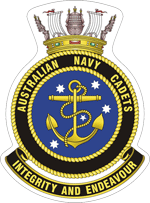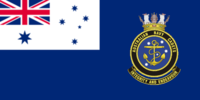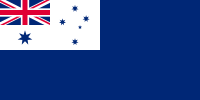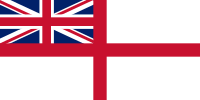Australian Navy Cadets
| Australian Navy Cadets | |
|---|---|
 Australian Navy Cadet Crest | |
| Active | 1907 – present |
| Country | |
| Allegiance | HM Queen Elizabeth II |
| Branch | Navy |
| Type | Volunteer Youth Organisation |
| Size | 92 Units, 2,200 Cadets |
| Part of | Australian Defence Force Cadets |
| Headquarters | Directorate ANC, Russell Offices, Canberra |
| Nickname(s) | ANC |
| Motto(s) | Integrity and Endeavour |
| March | Royal Australian Navy |
| Anniversaries | 1 July |
| Vessels Operated | Corsair, Envy, Various Powerboats, RHIB, Scruffy, Bosun's mate, Hobi Catamaran |
| Website | www.navycadets.gov.au |
| Commanders | |
| Director General ANC | Commodore Mark Hill, CSC, RAN |
| National Commander ANC | Captain Kerry Rayner, OAM, ANC |
| Director of Flotilla's | Commander Wayne Larsen, ANC |
| Chief of Staff | Commander Richard Trigg, ANC |
| Notable commanders | RADM Sir David Martin, KCMG, AO CAPT Gavin Reeves |
| Insignia | |
| Australian Navy Cadets Ensign (2001–present) |  |
| Naval Reserve Cadets Ensign (1972–2001) |  |
| Australian Sea Cadet Corps Ensign (1956–1972) |  |
| Naval Ensign (1907–1956) |  |
The Australian Navy Cadets (ANC) is a voluntary youth organisation owned and sponsored by the Royal Australian Navy. Together with the Australian Air Force Cadets and Australian Army Cadets, it forms the Australian Defence Force Cadets. It hosts over 91 units.
Contents
1 History
2 Aims
3 Organisation
3.1 ANC ranks
3.1.1 Staff ranks
3.1.2 Cadet Ranks
3.1.3 Volunteers
3.2 Former national commanders and directors general
4 Uniforms/Awards
5 Activities and Training
5.1 Courses and Skills
5.2 ANC and RAN Twinning Program
5.3 International Exchanges
5.4 ANC and Young Endeavour Youth Scheme
5.5 Specialisations
6 Membership
6.1 Cadet
6.2 Staff
7 See also
8 Notes
9 References
10 External links
History
The organisation was founded in the early 1900s and officially recognised under the Naval Defence Act in 1910. Prior to 1973, the organisation was known as the Australian Sea Cadet Corps, and was jointly administered by the Royal Australian Navy and the Navy League of Australia. After 1973, the Navy assumed full responsibility for the Corps, which was renamed the Naval Reserve Cadets. The Australian Government review, 'Cadets The Future' recommended a final name change to Australian Navy Cadets in 2000.[1]
- Admiral of the Corps
| Appointee | From | To |
|---|---|---|
| King George VI | 1942 | 1952 |
| Prince Philip, Duke of Edinburgh | 1952 | 1992 |
| Prince Andrew, Duke of York | 1992 | Present |
Below is a list of names held by both the Naval League and Defence run/sponsored programs including the original 'Church of England – Boys Naval Brigade' from 1901 to 1911:[2]
- Boys Naval Brigades (Victoria) 1901–1911 (Run in conjunction with the Church of England)
- Australian Naval Cadet Corps ANCC 1907–1950 (Defence)
- Navy League Sea Cadet Corps NLSCC (1920–1950) (Navy League)
- RANR Cadets 1950–1973 (Defence)
- Australian Sea Cadet Corps ASCC (1950–1972) (Navy League)
- (1973– Navy League and Defence cadets merged into one unit, the NRC)
- Naval Reserve Cadets NRC (1972-31 March 2000) (Defence)
- Australian Navy Cadets ANC (1 April 2000 – Present) (Defence)
Aims
ANC training is nautical in nature and includes waterborne activities, which can include navigation, communications, first aid, drill, maritime history, firearms proficiency, and adventurous training.[3] The ANC also aims to achieve the following with its training program:
- develop an interest in the Navy and its tradition;
- encourage cadets to continue military or community service;
- give cadets a foundation of military knowledge and discipline;
- develop the qualities of leadership, self-discipline, self-reliance, and initiative; and
- provide training that may later assist in achieving competencies required during Navy induction training.
Organisation
The 91 Training Ships (units) across Australia have a total membership around 400 staff and 2,200 cadets,[4] including several that have been formed in high schools. However, 2012 reporting suggested membership has fallen drastically to about 1,600.[citation needed] The ANC adheres to a rank structure similar to the Royal Australian Navy, with cadets having the opportunity to progress from the rank of cadet recruit to cadet midshipman. Each unit has a complement which lays out how many cadets the unit is allowed to carry and how many are allowed at each rank. Training camps and examinations are held for promotion in rank. The structure and organisation of the ANC is based on that of the Royal Australian Navy, but additionally features a large community-involvement component.
ANC ranks
Ranks of the Australian Navy Cadets are divided into staff ranks and cadets ranks. Volunteers do not become staff until appointed by the ANC.
Staff ranks
| Insignia |  |  |  |  |  |
|---|---|---|---|---|---|
| Rank | Sub Lieutenant ANC | Lieutenant ANC | Lieutenant Commander ANC | Commander ANC | Captain ANC |
| Abbreviation | SBLT, ANC | LEUT, ANC | LCDR, ANC | CMDR, ANC | CAPT, ANC |
| Insignia |  |  |  |  |  | |
|---|---|---|---|---|---|---|
| Rank | Provisional Instructor ANC | Able Seaman ANC (Inactive rank) | Leading Seaman ANC (Inactive rank) | Petty Officer ANC | Chief Petty Officer ANC | Warrant Officer ANC (Inactive rank) |
| Abbreviation | PIANC | ABANC | LSANC | POANC | CPOANC | WOANC |
Example of Use (officer); LCDR Joe Blogg, ANC
Example of Use (Instructor); POANC Joe Blogg
Cadet Ranks
| Insignia |  |  |  |  |  |  |  |  |
|---|---|---|---|---|---|---|---|---|
| Rank | Cadet Recruit | Cadet Seaman | Cadet Able Seaman | Cadet Leading Seaman | Cadet Petty Officer | Cadet Chief Petty Officer | Cadet Warrant Officer | Midshipman ANC (inactive rank) |
| Abbreviation | CDTRCT | CDTSMN | CDTAB | CDTLS | CDTPO | CDTCPO | CDTWO | MIDN, ANC |
Example of Use; CDTPO Joe Bloggs
Volunteers
- Unit Support Volunteer – USV
Example of Use; USV Joe Bloggs
Former national commanders and directors general
The basic naval reserve cadet (NRC) command structure prior to 2001 was:
Director of Naval Reserves and Cadets (DNRC) was a RANR Officer in Canberra who had overall authority of the Naval Reserve Cadets. Each state had a Senior Officer Naval Reserve Cadets (SONRC) who answered to the LNA or Local Naval Authority usually the Commanding Officer (CO) of the establishment on which the NRCHQ of that state resided. A Cadet Liaison Officer (CLO), usually a RANR Officer, was situated in HMAS Cairns, HMAS Moreton, HMAS Watson, HMAS Lonsdale, HMAS Encounter, HMAS Huon and HMAS Leeuwin (all shore bases at the time). The CLO had responsibility for the liaising between the NRC and RAN in their state. There was no national HQ or national staff until the ANC was established in 2001.
| Rank | Name | Post-Nominals | Service Branch | Years as National Commander (NCANC) Director (DNRC) | Notes |
|---|---|---|---|---|---|
Director NRC | |||||
| Captain | David Martin | RAN | 1973–1974 | Later known as Rear Admiral Sir David Martin KCMG AO RAN – 34th Governor of New South Wales | |
| Commander | Allan Vidler | NRC | |||
| Commander | Christine Reinks | NRC | |||
National Commander ANC | |||||
| Captain | Gavin Reeves | ANC | 2000–25 February 2007 | CAPT Reeves was awarded the Centenary Medal in 2001 for services to the ANC, NRC and the Australian Sea Cadet Corps. | |
| Commander | John Goss | AM | RANR | 25 February 2007 – 13 August 2008 | (Acting) |
| Captain | Eliot Fisher | ESM | ANC | 13 August 2008 – 13 August 2011 | |
| Captain | John Gill | ANC | 13 August 2011 – 30 June 2014 | ||
| Captain | Eliot Fisher | ESM, OAM | ANC | 13 August 2014 - 1 January 2017 | |
| Captain | Kerry Rayner | OAM | ANC | 1 January 2017 | |
Prior to 2001 the ANC did not have the title or position 'Director General ANC', instead the overall Commander's position was called 'Director of Reserves Navy' which was a RAN – RANR position.
| Rank | Name | Post- Nominals | Service Branch | Years as Director General (DGANC) Director General ANC & Reserves (DGANCR) | Notes |
|---|---|---|---|---|---|
Director General ANC | |||||
| Commodore | Nigel Coates | AM | RAN | 2005–2007 | Later known as Rear Admiral Nigel Coates AM RAN |
| Commodore | Karel de Laat | CSC, RFD | RANR | 2007-2007 | Later known as Rear Admiral Karel de Laat CSC RFD RANR |
| Commodore | Michael Smith | AM | RANR | 2007-? | |
| Commodore | Geoff Geraghty | AM | RANR | ? – 1 February 2014 | |
Director General Australian Navy Cadets and Reserves | |||||
| Commodore | Geoff Geraghty | AM | RANR | 2 February 2014 – 30 November 2014 | |
| Commodore | Bruce Kafer | AM, CSC | RANR | 1 December 2014 – 9 March 2017 | |
| Commodore | Mark Hill | CSC | RANR | 10 March 2017 – Present | |
Uniforms/Awards
The uniforms of the Australian Navy Cadets are based on that of the Royal Australian Navy (RAN), with only a few differences such as the shoulder flashes of the ANC reading "AUSTRALIAN NAVY CADETS" as opposed to the RAN's "AUSTRALIA" flashes.
| Award | Staff | Cadet | Years Service | Notes |
|---|---|---|---|---|
| Personal Efficiency Badge | All Ranks | All Ranks (except RCT) | completion of set qualification criteria personal readiness with 12 month renewal | Staff (Silver Badges with Gold Wheel) Cadet (Silver Badge with Silver Wheel) |
| Long Service & Good Conduct Stripe | POANC | All Ranks (except WO & MIDN) | Staff (1 for every 4 years of Service) (1 for 4 years service as a cadet) (1 for every 4 years service in the RAN or RANR) (maximum of 3 stripes) Cadet (1 stripe for every year of service) (maximum of 3 stripes) | |
| 5 Year Service Certificate | All Ranks | N/A | completion of 5 years service | |
| 10 Year Service Certificate | All Ranks | N/A | completion of 10 years service | |
| Australian Cadet Forces Service Medal | All Ranks | N/A | For 15 Years Long Service | A bar is awarded for every five years thereafter. |
| National Commander ANC Commendation | All Ranks | N/A | for meritorious service | In Gold, Silver and Bronze. |
| Director General ANC Commendation | All Ranks | N/A | for extraordinary meritorious service | In Gold, Silver and Bronze. |
Conspicuous Service Medal (CSM) | All Ranks | N/A | The medal recognises commendable achievement or commitment to duty in a non-combative context. It is awarded to members of the Australian Defence Force and certain other people for example, Defence Force chaplains. | |
Conspicuous Service Cross (CSC) | All Ranks | N/A | The cross recognises exceptional dedication to duty or outstanding achievement in skills or judgement in a non-combative context. It is awarded to members of the Australian Defence Force and certain other people such as members of philanthropic organisations. |
Activities and Training

Australian Navy Cadets marching during Remembrance Day ceremony Kings Park, Western Australia, 11 November 2012.
Courses and Skills
Cadets learn teamwork and leadership skills, and put these into practice at regular weekly parades. Cadets also have the opportunity to attend training camps for the purpose of promotion in rank, standard training, or to gain additional qualifications.
TS Hobart, a dedicated band unit, also offers musical activities as well as the normal cadet curriculum.
ANC and RAN Twinning Program
All ANC units can participate in sea rides on Royal Australian Navy ships as part of the "Twinning" program, an initiative to provide a link between ANC units and RAN ships.[5]
International Exchanges
As the ANC is part of the International Sea Cadet Association, the opportunity is present for members to go on exchange programs with overseas cadet groups.
ANC and Young Endeavour Youth Scheme
The ANC/Young Endeavour Voyage Scheme is a sailing program for Australian Navy Cadets aged 16 and over, focused on building leadership, teamwork and communication skills through sail training. This scheme is being sponsored by the RAN and extends to 24 Australian Navy Cadets and three ANC staff members the chance to participate in two dedicated voyages on STS Young Endeavour. Sponsorship covers all voyage fees, airfares and accommodation. Nominations are sought from cadets over the age of 16 years and placement is offered to the top 24 cadets who can demonstrate outstanding personal and leadership qualities and who have made a valuable contribution to their local community during the past 12 months.
Over the course of the voyage, 24 Navy Cadets and three ANC staff members learn aspects of sailing a 44-metre, square rigged tall ship on the open sea including climbing the two 30 metre masts, setting sails, navigating, keeping watch, taking the helm and helping in the galley. ANC crew are trained by a professional Royal Australian Navy crew who are there to ensure the highest standards of safety and care.
The YEYS staff lead and run the Ship's usual training, games/sport and activity programs, with all ANC staff and cadets coming under the direction and supervision of the Ship's crew. This is not a military program. ANC staff do not have a leadership role while embarked in STS Young Endeavour and fully participate in the ship's youth development program on an equal footing with the cadets whom they would usually lead. The focus of the voyage is on self-development, the atmosphere is informal and all ship's company and youth crew are addressed on a first name basis.
Specialisations
When Cadets complete the Initial General Training Course (GT), they have the opportunity to go and do a specialisation course. Having a specialisation is not necessary to get promoted to Leading Seamen but having done at least one Annual Continuous Training (ACT) is. However, some flotilla's will require Able Seaman to do a leadership and management course before they can be promoted. Cadets are allowed to have more than one specialisation or category but each cadet will have a primary specialisation. Specialist courses are run on ACTs (as well as GT) which usually happen once a year. The awarding of categories mirrors that of the Royal Australian Navy (RAN) even though sailors in the RAN can only gain one rate at any one time. The specialisations are available to cadets from the rank of Able Seaman.
The specialisations available in the Australian Navy Cadets are:
- Seamanship (SMNS)
- Marine Technician (MT)
- Ceremonial and weapons safety (CWS)
- Cook (CK)
- Communications (COM)
- Musician (MUSN)
- Stores (STR)
- Hydrographic Surveyor (HS)
Promotional Specialisations:
- General Training (GT, required to become an Able Seaman)
- Leadership and Managment (L&M, required to become a Leading Seaman)
- General Training Instructor/Petty Officer Qualifications (PO Quals, required to become a Petty Officer)
- Whole Ships Coordinator/Chief Petty Officer Qualifications (Chief Quals, required to become a Chief Petty Officer)
Former specialisations:
- Physical Training Instructor (PTI)
- Cadet Safety Representative (CSR)
- Naval Airman (NA)
- Writer (WTR)
Cadets can also attend an advanced course on most of the above specialisations.
Cuff Rates:
CSA (Cadet Special Award) are completed at cadets, camps and ACT (Annual Continuous Training). Cuff rates is a badge you get after completing the course and it is worn on ceremonial uniforms, with a maximum of three to be worn. Cuff rate include:
- Sailing
- Power boating
- Canoeing
- Pulling
- Sailboarding
- Drum Corp
- Bugle Corp
- Duke of Edinburgh Award
- Adventurous Training
- Diving
- Weapons Safety
- Marksmanship
- Parachutist
- First Aid
- Solo Flight
the Adventurous Training Award is run by the Australian Army Cadets and is worn above the readiness badge.
Membership

Australian Navy Cadet and a Royal Canadian Sea Cadet Petty Officer First Class during an international training activity
All cadets and staff in the ANC are workers of the ADF (Australian Defence Force) in accordance to the workplace health and safety act classifying them as workers but are not required to undertake military service.[6]
Cadet
The age period of membership as a cadet is twelve turning thirteen on the year of entry, to the day before turning eighteen. After turning eighteen years of age, it is no longer possible to be a member of the ANC as a cadet.[7] There is no specific recruitment time.
Staff
All cadet units are staffed by paid officers and instructors, although some units may also have volunteer instructors. Adult staff involved in the organisation come from a variety of backgrounds and professions including:
- Teachers
- Members of community organisations
- Ex-cadets
- Parents and community members
- Ex-servicemen and women
- Occupational health and safety consultants
- Specialist personnel such as HR, change or occupational health and safety managers, administrators or finance officers
- People who provide support on a continuing or as required basis[8]
Some Cadet Staff are appointed for their professional expertise in instruction or administration. Cadets may apply to become Officers or Instructors when they leave the Cadet program.[8]
The current National Command Authority are;
Commodore Mark Hill, CSC, RANR – Director General ANCR
Captain Kerry Rayner, OAM, ANC – National Commander
Commander Wayne Larsen, ANC – Director of Flotillas
Commander Lisa Foley, ANC – Director Training
Commander Martin Blume, ANC - Director Communications and Coordination
Commander Helen Trigg, ANC – Chairman of the ANC Dispute Resolution Agency
See also
- Australian Army Cadets
- Australian Air Force Cadets
- Australian Defence Force Cadets
- International Sea Cadet Association
- Other Sea Cadet organisations
Notes
^ History – Australian Navy Cadets (ANC Official Website) [1].
^ ABR5128 (AL2) Chapter 16
^ Official ANC Website Australian Navy Cadets – ANC. Retrieved 8 March 2008. Archived 24 January 2011 at WebCite
^ "Navy and cadets to bond through twinning initiative" (PDF). Sea Talk. Royal Australian Navy. Summer 2006. p. 29. Archived (PDF) from the original on 24 January 2011. Retrieved 2008-08-21..mw-parser-output cite.citation{font-style:inherit}.mw-parser-output .citation q{quotes:"""""""'""'"}.mw-parser-output .citation .cs1-lock-free a{background:url("//upload.wikimedia.org/wikipedia/commons/thumb/6/65/Lock-green.svg/9px-Lock-green.svg.png")no-repeat;background-position:right .1em center}.mw-parser-output .citation .cs1-lock-limited a,.mw-parser-output .citation .cs1-lock-registration a{background:url("//upload.wikimedia.org/wikipedia/commons/thumb/d/d6/Lock-gray-alt-2.svg/9px-Lock-gray-alt-2.svg.png")no-repeat;background-position:right .1em center}.mw-parser-output .citation .cs1-lock-subscription a{background:url("//upload.wikimedia.org/wikipedia/commons/thumb/a/aa/Lock-red-alt-2.svg/9px-Lock-red-alt-2.svg.png")no-repeat;background-position:right .1em center}.mw-parser-output .cs1-subscription,.mw-parser-output .cs1-registration{color:#555}.mw-parser-output .cs1-subscription span,.mw-parser-output .cs1-registration span{border-bottom:1px dotted;cursor:help}.mw-parser-output .cs1-ws-icon a{background:url("//upload.wikimedia.org/wikipedia/commons/thumb/4/4c/Wikisource-logo.svg/12px-Wikisource-logo.svg.png")no-repeat;background-position:right .1em center}.mw-parser-output code.cs1-code{color:inherit;background:inherit;border:inherit;padding:inherit}.mw-parser-output .cs1-hidden-error{display:none;font-size:100%}.mw-parser-output .cs1-visible-error{font-size:100%}.mw-parser-output .cs1-maint{display:none;color:#33aa33;margin-left:0.3em}.mw-parser-output .cs1-subscription,.mw-parser-output .cs1-registration,.mw-parser-output .cs1-format{font-size:95%}.mw-parser-output .cs1-kern-left,.mw-parser-output .cs1-kern-wl-left{padding-left:0.2em}.mw-parser-output .cs1-kern-right,.mw-parser-output .cs1-kern-wl-right{padding-right:0.2em}
^ ABR5128 (AL2) – Chapter 7
^ How to Join - Australian Navy Cadets How to Join - Australian Navy Cadets. Retrieved 27 October 2008. Archived 24 January 2011 at WebCite
^ ab Australian Navy Cadets – Staff FAQs [2]. Retrieved 8 March 2008.
References
- ABR 5128 (AL2) — Policy and Operating Instructions Manual for the Australian Navy Cadets
External links
| Wikimedia Commons has media related to Australian Navy Cadets. |
- International Sea Cadet Association
- Navy League of Australia Federal Council report
- Australian Defence Force Cadets – Cadetnet
- Royal Australian Navy
- Cadets WA